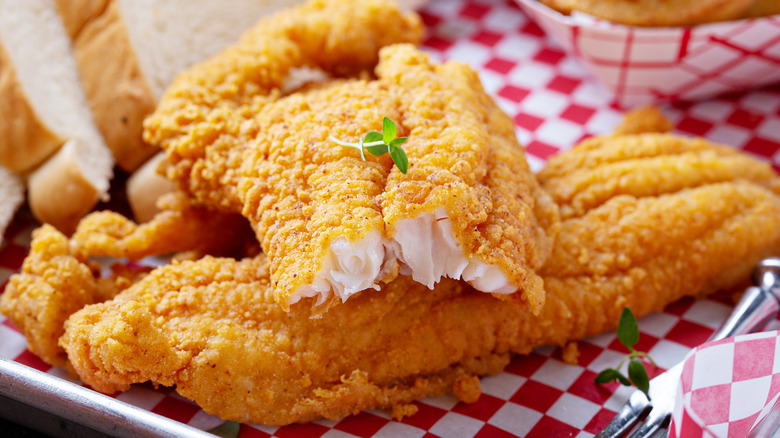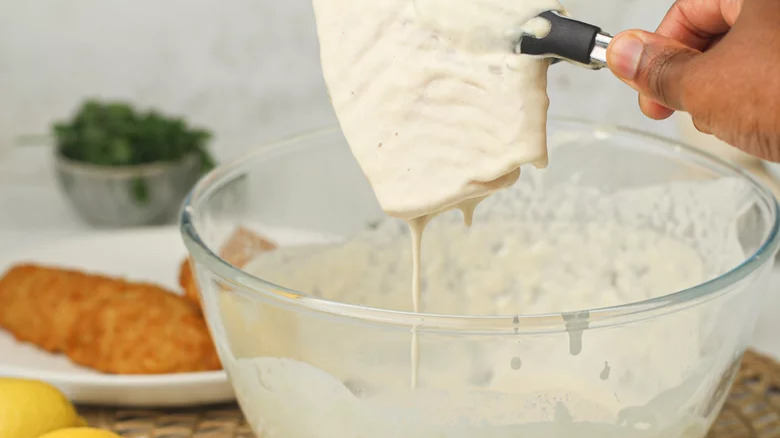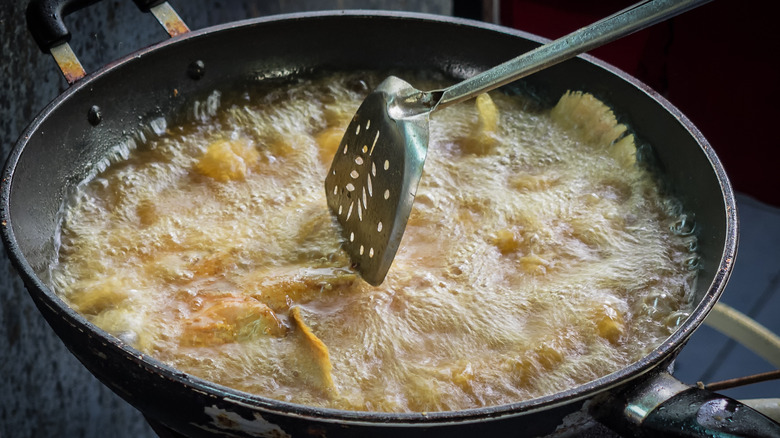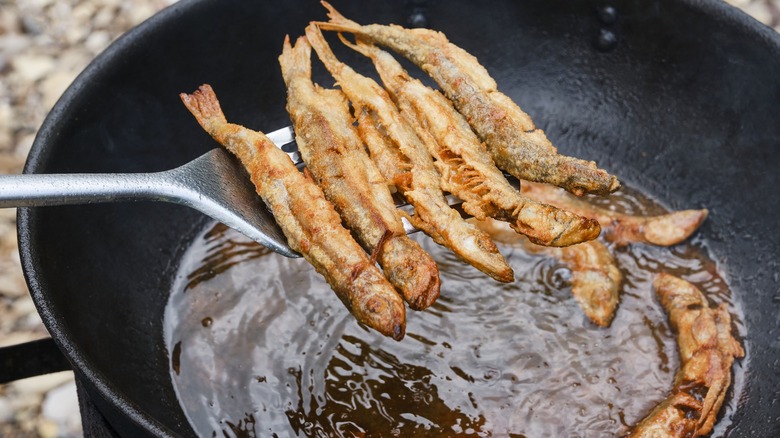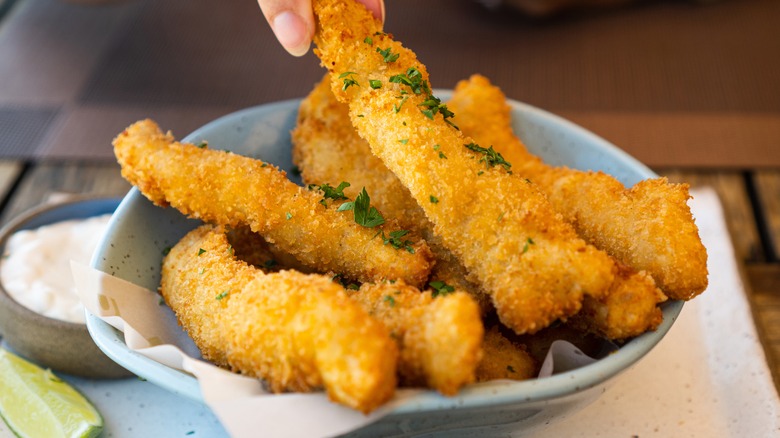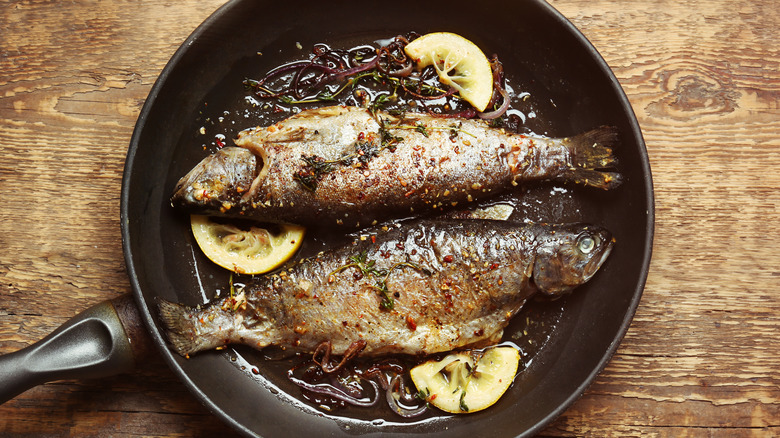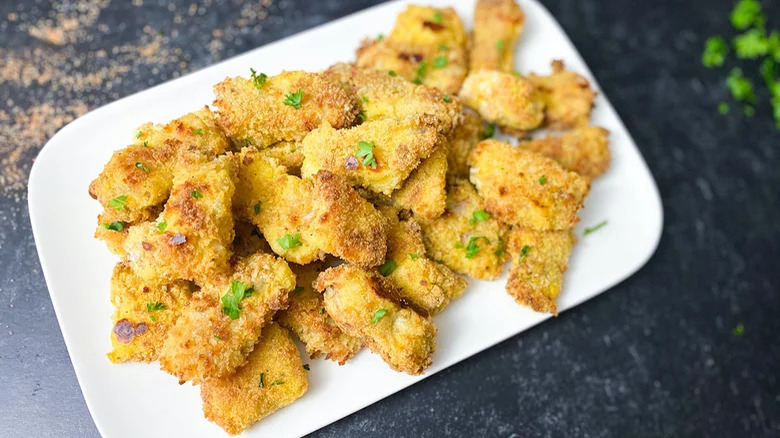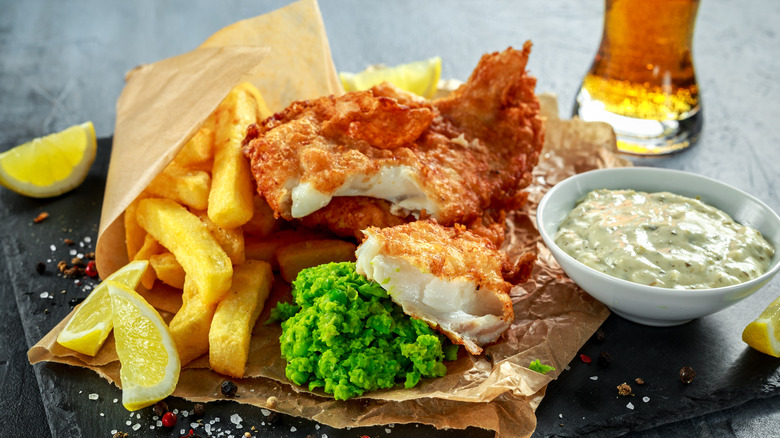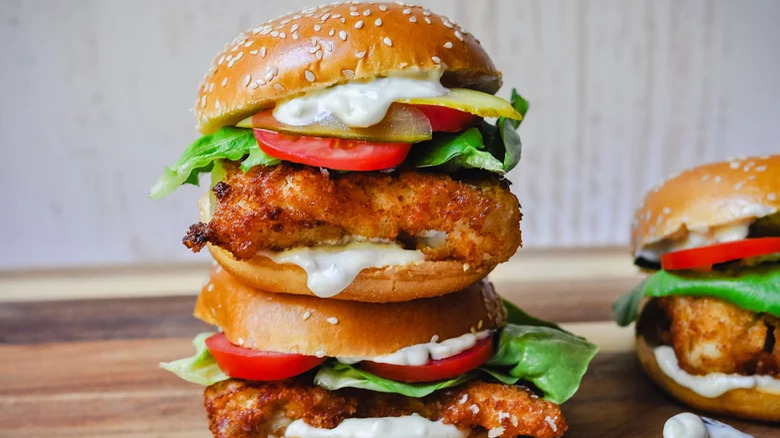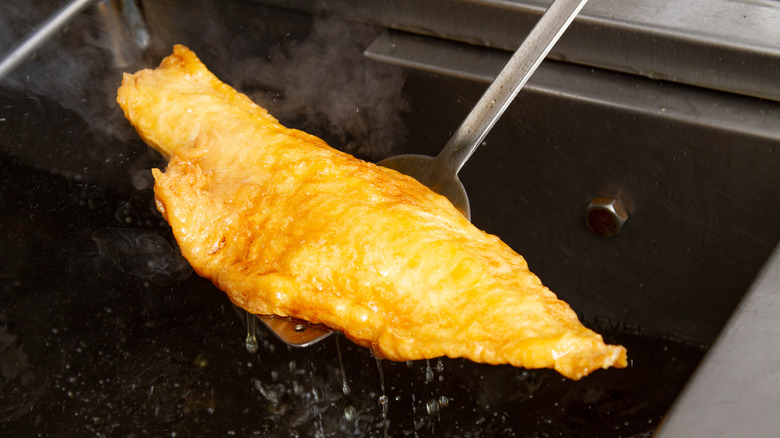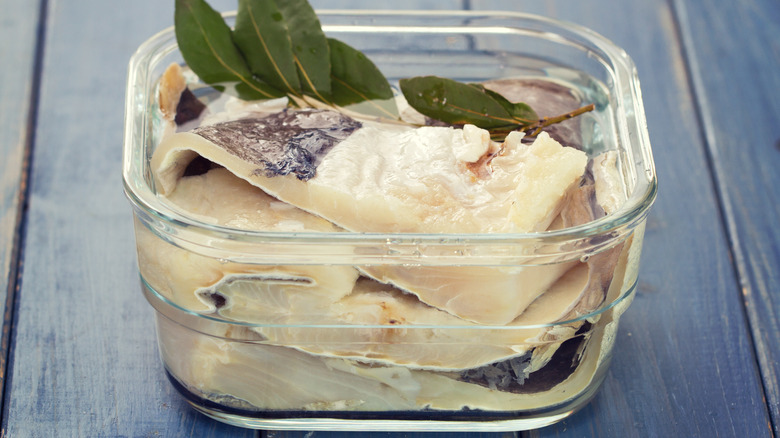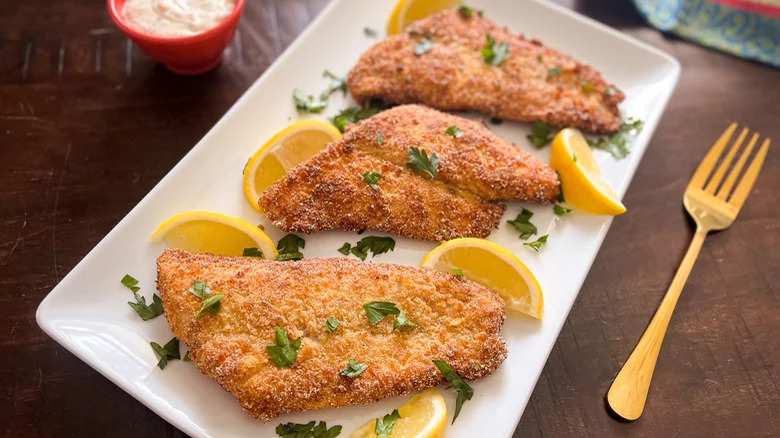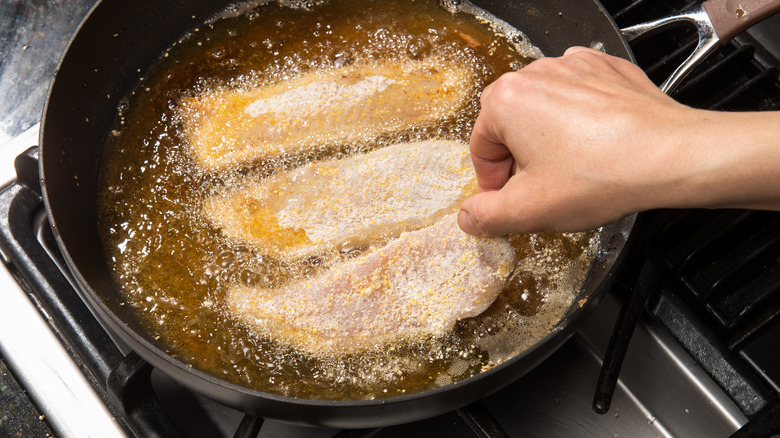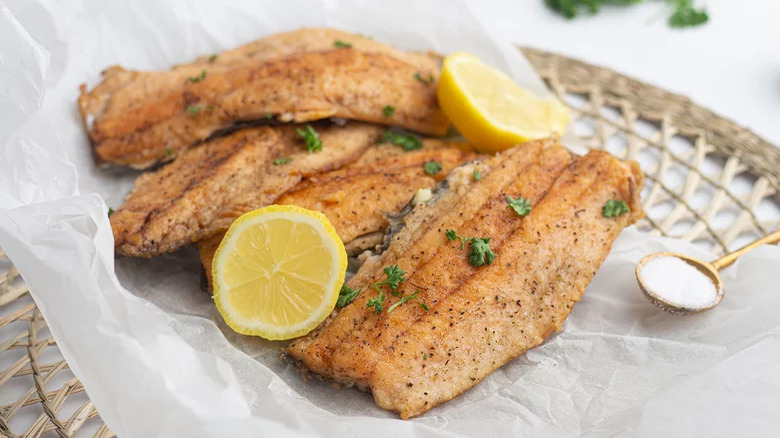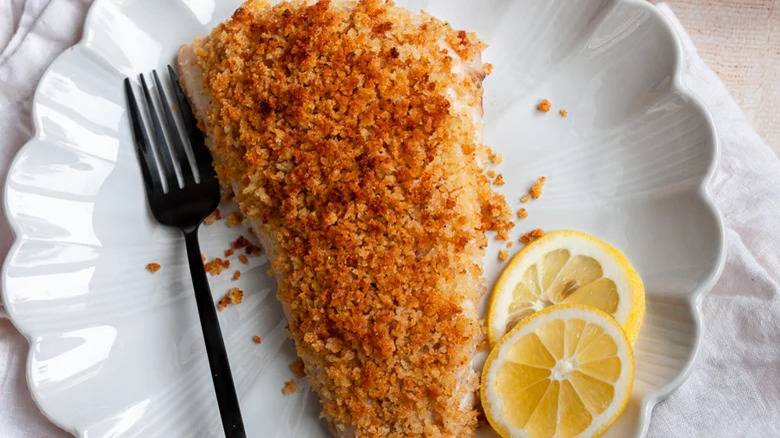14 Tips To Make Your Fried Fish Taste As If You Ordered It From A Pub
There are some tasty fish fries happening in eateries across the country. But while it's great to have someone else cook for you, for an increasing number of foodies, eating in is the new eating out. And nothing is stopping you from recreating your favorite fried fish dishes that you enjoy at the pub right at home.
But how on earth do those pro chefs get the batter so crunchy and light? What oil should you use, and how much? The difference between a limp, greasy piece of fried fish and a can't-get-enough crunchy fry is huge. But it's easy to mess up fried fish if your coating isn't quite right, your oil isn't hot enough, or you use the wrong equipment. Plus, there are plenty of tricks to enhance the flavor and texture as well. Read on for 14 tips to make your fried fish taste as if you ordered it from a pub.
1. Mix a light and crispy batter
There's nothing worse than heavy, soggy, and ultimately greasy batter that's sliding off a fillet of fish. Fabulous pub versions always seem to be so light and crispy that they look like fried works of art almost floating off the plate. There's nothing better when such a dish arrives than that first crunch as you push the side of your fork into that brittle batter, revealing the soft, perfectly cooked fish inside. Believe itor not, you too can make this brilliant batter at home. You just need to follow a few tricks.
For best results, follow our recipe for copycat Long John Silver's fish with wild-caught cod. For the batter, you're not just going to mix flour and water, but make a bubbling and flavorfully seasoned tempura batter. Combine regular flour with corn flour, cornstarch, MSG, baking powder, and baking. Flavor the mix with paprika, garlic salt, onion powder, and white pepper. Instead of plain water, add club soda. It's what all the pro chefs do to give batter that thick yet crackling texture. If you want to simplify the recipe, you can make a light and crispy fish batter with just flour, cornstarch, baking powder, and seltzer. Just be sure not to overmix the ingredients, as the bubbles will dispel and your batter will lose its lightness.
2. Get the oil hot enough
Professional kitchens cooking for large numbers not only have specialized equipment but also large pans and fryers. This makes turning up the heat and cooking a big batch of fried fish in hot oil a little easier than on a stove at home. Pub chefs are used to cooking the dishes on their menus, too, so they've also got the added experience of frying fish each day. While you can't necessarily upgrade your kitchen, if there's one tip from the pros you should follow, its to turn up the heat.
Getting your oil hot enough makes all the difference when you're frying fish. If the temperatures aren't right, then the batter is going to soak up the grease, and this prevents that chef-style crispy result. A general guide is to cook thin fish fillets or pieces at 350 degrees Fahrenheit, or around 375 degrees Fahrenheit for denser, thicker battered fish. Use a thermometer in the oil to get this just right. And if the oil gets too hot, Gordon Ramsay advises turning the stove off and adding some room temperature oil to your pan. However, it's important never to fill your pan more than half full with oil, as it bubbles up when heated.
3. Cook for the right amount of time
Are you one of those home cooks that's super precise in the kitchen and follows strict recipe rules? Or is there a lot of winging it and guesstimates? If you're a dab hand at cooking then you might prefer to go with the flow rather than set the timer. However, one of the reasons fried fish tastes so darned good when you order it from a pub is that the chefs cook it for exactly the right amount of time.
Cooking fish isn't easy. It can go from raw to overcooked really quickly. Deep frying cooks fish a lot quicker, cooking a whole fish or fillet pieces in around three to five minutes as opposed to pan-frying, which takes anywhere from seven to 15 minutes. If you're pan-frying fish, you can press on it to check whether it's done. If it gives a little but is fairly firm then it's probably ready to remove from the heat. Another trick you can try: Stick a knife into the center and then touch the tip when you pull it out. If it's still cool then your fish needs to be cooked a little longer.
4. Add a special ingredient to the batter
Chefs use all sorts of clever little tricks to elevate their dishes. And what's great is they're often simple ideas that you can easily follow at home. Next time you're making some fried fish, why not try adding an unusual ingredient to make them extra crispy? It's something that you're likely to have at home as it's nothing you won't have used a myriad of times before — potato flakes.
Instead of turning your potato flakes into instant mashed potatoes, add them to your fried fish batter instead. It adds some extra texture and crunch. The flakes also keep the fish protected from drying out and sizzle up in the hot oil to give your fried fish a rough, crumbed-like surface texture. Submerge your fish in an egg wash and then coat it in potato flakes. You could also add some parmesan cheese to the mix to elevate the flavor. Feel free to add seasonings, too. This is also a great tip if you want a gluten-free version of golden brown fried fish.
5. Use the right oil for frying
There are so many different types of oil to choose from that it can be downright confusing to know which one to choose. The best type of oil for frying is one that has a smoke point of at least 400 degrees Fahrenheit. What this means is that you can safely heat it and it will only start smoking or burning once it reaches this temperature. If the smoke point of your oil is too low then you won't be able to get it hot enough for frying. You're also going to want to use an oil with a neutral taste so that the flavor of your fish isn't overtaken.
Canola, rice bran oil, and light olive oil, as well as sunflower, safflower, and corn oil, are all perfectly fine for deep frying with. You can pan-fry fish with extra virgin olive oil, which is traditional in many Mediterranean countries like Greece, but it's not an oil that's used for deep-frying because the smoke point is too low — not mention it would prove expensive if used in large quantities.
6. Make fish nuggets
Chowing down on some fried fish in a pub is so much more relaxed than in a fine-dining restaurant. Aside from the atmosphere and being able to watch sports on the TV screens in the pub, the bar snacks can also be pretty great. Say it's a Friday, and all you want to do is down a cold one and munch on something fried and delicious, but you can't get to the pub. No problem — just grab some fillets of your favorite fish and make some bar-style fare at home instead. Forget frying a whole fish, or even a fillet, and leave those frozen fish sticks where they are. Instead, fry yourself up some easy, pub-style fish nuggets for a crispy bite.
If you don't want to get the deep-fryer out, then a great tip is to bake your fish in the oven instead. Our oven-fried catfish nuggets are breaded and then cooked on a greased tray in the oven for 20 minutes. The result? A crunchy texture that tastes fried but isn't. To amplify the taste, add cayenne and chili powder to the coating, or some Cajun seasoning or Old Bay. You can also use a different white fish for this recipe, such as cod or tilapia.
7. Add beer to the batter for British-style fish and chips
If there's one fried fish dish you've got to order at the pub, it's British-style fish and chips. You just can't beat that thick, crispy batter, soft fries, and the bursts of salt and malt vinegar flavor, served with ketchup, tartare sauce, and lemon wedges. In parts of the U.S., this dish is also served with creamy coleslaw.
You can create this iconic style of fish and chips at home by adding beer to your batter. Mix a light-colored beer or lager with flour, baking powder, salt, and any seasonings you prefer, like paprika or Old Bay. To really make the batter stick, dredge your fish in flour before and after dipping it in the batter. Another good tip is to keep hold of the fish using tongs when you first plunge it into the hot oil. This allows the batter to harden enough to be stable before the fish floats freely in the hot oil.
8. Serve fried fish in a burger bun
It's often only when you go to the pub that you remember how fantastic a fried fish sandwich is. It's a refreshing change from a beef burger, but with all the same fillings it's just as tasty, if not more so. Our fried cod sandwich is tender and crispy and brings home a classic pub staple. To make sure it's just as good as your favorite bar version, and definitely better than any drive-thru, you'll need to follow a few tips.
Use good quality cod fillets for this. They're so juicy and have just the right springy and soft texture to hold up in a sandwich without turning to mush or flaking too much. You can also use haddock or pollock. Breading the fish adds extra crunch and this recipe coats the fish in panko. Fry the fish at 350 degrees Fahrenheit. Make sure to cook the fish in batches if you're making a few sandwiches, that way the oil won't cool down, leaving your fish soggy. It's really important to get rid of any excess grease by putting the fried fish on a kitchen towel before making your sandwich. Use sesame buns or any other type of roll that you like, loading up your sandwich with the freshly fried fish and tartar sauce first, and then sliced lettuce, tomato, and pickles.
9. Don't use tongs
Seared salmon is a popular pan-fried dish and what makes it super scrumptious is the crispy skin. You start by frying the fish skin-side down and putting pressure on the top of the fillet so that it crisps up. You then need to turn it over and cook it on the other side so that's it evenly fried. A spatula works best for this. Salmon becomes a little flaky when it's cooked and can slide apart easily if you're not gentle enough when handling it. Tongs that pinch part of the fish aren't the best fit.
You also don't want to use tongs when frying battered fish if you want the result to look as good as it does when served at a good pub. As well as damaging the fish, the grip of the tongs can pull the batter off. If this happens, it leaves the fish is exposed which allows oil to seep in, creating a soggy, greasy mess of a dish. Try using a fork, metal slotted spoon, or a spider strainer that acts like a net and can help you turn frying food around in a big pan.
10. Choose fish that you don't usually cook at home
When you pay a visit to your favorite pub for a snack, do you always order the same dishes off of the menu? People can be creatures of habit, and while it's good to push the culinary boundaries sometimes, it's also comforting if you know what you're getting. However, what can make a pub menu stand out is if it's not just serving up run-of-the-mill fried fish dishes. Take this spirit of adventure into your kitchen frying some fish you're not eating at home for a change.
Sardines are great when fried. Another fish you might not have tried include Arctic char, barramundi, or red snapper. Asian sea bass is delicious pan-fried with a lemon, garlic, and butter sauce. Meanwhile, bluegill bream, which is found naturally along the East Coast and northern Mexico, is a fish that's best fried whole to enjoy its milky flavor and robust texture. Another palatable white and flaky fish dish is crispy fried catfish. And fried salt cod is perfect for fish and chips. Soak the cod in water in the fridge for 24 hours to get rid of some of the salt. Then cook it in a batter made with flour, water, and olive oil.
11. Fry catfish in cornmeal batter
In the South especially, catfish is a traditional fish that's enjoyed fried. And it's served in pubs across the U.S. as a crunchy snack. If you want to make it the right way at home, follow this tip from a master of southern cuisine, Rodney Scott. The barbecue pitmaster is known for his smoking and grilling skills, but he also has a few tricks up his sleeve when it comes to the correct way to fry catfish. He told Thrillist his top tip, which he got from his grandmother, is to use cornmeal to coat the fish. Add finely ground cornmeal to all-purpose flour, with some black pepper, salt, and some MSG. It wouldn't be a true southern bite without some heat, so he also adds some cayenne pepper to the mix as well.
You can also follow our simple recipe for crispy fried catfish, which adds several flavorful spices to the mix. A key step here is to make sure the oil is super hot, so your cornmeal coating gets nice and crispy instead of soggy. And to check the oil is hot enough if you don't have a thermometer, you can just add a little cornmeal right to the pan. The oil is ready when the cornmeal starts to sizzle in the oil rather than sitting on the surface.
12. Don't add too much oil to your pan
When you pan-fry fish you still need a generous amount of oil to get that fried flavor and crispy texture. When you're served fish like this in the pub it often has a golden-brown crust that you can hear crackle when you run your fork along the surface. The key to getting the right taste and outer exterior is to use the right amount of oil. However, you don't want to use too much either, making for a fine balance. One rule of thumb is to make sure that the oil you pour into the pan doesn't cover more than a third of the fish that you're frying. Otherwise, it's likely going to soak up too much oil during the cooking process and turn out greasy. And you might want to use even less oil for fillets that are flakier or more fragile, as well as for naturally oily fish such as salmon and mackerel.
13. Dredge delicate fish in flour
Sometimes when you order pan-fried fish in the pub, it will come out crispy with no battered coating on it at all. The reason for this is that some types of fish are not necessarily suited to a heavy, flour-based batter. And breadcrumbs don't work all the time, either. If you're wondering how these lighter pieces of fish are still able to achieve a nice crust on the outside, and want to replicate this at home, try our crispy fried trout recipe. Trout is a splendidly delicate fish that you're perhaps more likely to see on the menu at an upmarket gastro pub than at your down-to-earth sports bar. However, the method translates to other fried fish dishes in plenty of pub kitchens.
Before frying, dredge the fish fillets in a dry mix of flour, onion powder, garlic powder, salt, and pepper. This is only a dry mix, with no liquid or fat added to the mixture. To get the best crust, use fresh not frozen fillets, which are less watery, and pat the fish dry before dredging. Fry the fish in butter, turning once, and enjoy the flavorful end result, with just the right amount of bite to it.
14. Trying crusting your fish with panko
Making your own breadcrumbs can enhance a fried dish. You can choose what bread works best, and compared to many store-bought varieties the taste and texture are just so much better. But if you're not down for the extra work, rest assured this is not necessarily the best or only way to get the same ultra-crisp coating that's served up when you order your favorite pub snacks. One must-have ingredient for frying fish that many professional chefs can't fry without is panko.
Panko is a Japanese-style breadcrumb that's made from white, crustless bread. It looks and feels more like flakes rather than crumbs and the light, aerated texture lends a super crispy finish to any fish it coats. It's an absolute must-have for any fried fish fan and home cook. Make our breaded pan-fried cod by adding celery salt, paprika, cayenne, and black pepper to the panko coating. Or try our crusted baked red snapper. Grab a bag of panko next time you're at the store and create a pub menu of fried fish dishes to enjoy at home.
